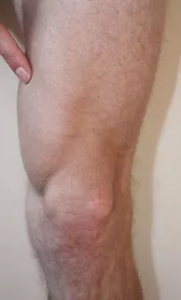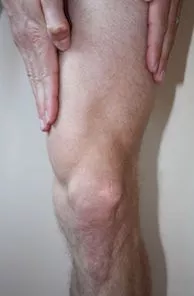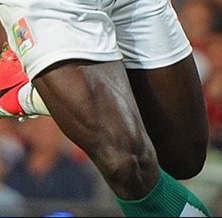Vastus Medialis Obliquus
This is a particular part of the vastus medialis muscle which is in itself one of the 4 components of the quadriceps muscle at the front of the thigh. The fibres of VMO have a more oblique alignment than the other fibres of Vastus Medialis, and are particularly important in patello-femoral (kneecap) problems.

The finger is pointing to VMO
Why is VMO Important?
VMO is an active and dynamic stabiliser of the patella. In healthy, pain free individuals the fibres of VMO are active throughout the range of movement. In patients with patella (kneecap) problems the fibres contract in phases, out of time, weakly and fatigue easily.
The specific role of VMO is to stabilise the patella within its groove and to control of the ‘tracking’ of the patella when the knee is bent and straightened. Mis-firing and weaknesses in the VMO cause mal-tracking of the patella and subsequent damage to surrounding structures and aching pain. The key to solving this problem is both getting the timing of VMO right, and the relative strength compared with the rest of the quadriceps group.

The inside hand is on VMO and the outside hand on Vastus Lateralis.
You need to feel VMO contact WITHOUT Vastus Lateralis
What Should I Do About My VMO Problems?
Here the issue is “Cause or effect” Chicken or Egg… Sometimes a weak VMO can develop through bad training habits, but often the VMO becomes weak because of an underlying problem in the knee, of which there can be many. It is usually the first muscle to show signs of an underling problem, and this should not be ignored. Clearly if this is the case then strengthening VMO wont make the problem go away. You are best off getting the knee checked by Dr. Amit first and making sure the important bits are in good order before trying to build up VMO. Knowledge is power! Have a look at some of the knee condition in the sports injuries pages to see if you can identify any problems that may have made your VMO waste away. Or go to the Contact Us page to arrange a knee check up.
How Can I Strengthen VMO?
First you must develop an awareness that it exists. This is the hard part, and it is very hard to describe. A bit like learning to raise one eyebrow without the other, its very hard to put in to words, but with time and practice it will come. Unless you have ever tried working on it its unlikely that you will be able to twitch VMO without contracting the whole of your quads. Long-term injuries such as Patello-femoral knee pain are a result of VMO malfunction, however some acute injuries cause the inhibition of VMO (e.g. Anterior Cruciate Ligament rupture, Patella dislocation & Meniscal tears). This makes it even more difficult.
To check the contraction of VMO Sit with your legs out in front of you and a rolled up towel under the injured knee (the knee should be slightly bent). Put your fingers over the area of VMO as shown in the picture.. Push your knee down into the towel. You will feel the muscle tightening under your fingers. If the muscle does not contract, continue to practice whilst pressing down gently on the muscle and concentrating on contracting the fibres underneath your fingers. Now put your other hand on the outside muscle ‘Vastus Lateralis’ and do the same. You will feel this contract too. The aim is to learn to contract VMO on its own without Vastus Lateralis. Masses of practice is needed!
Holding the Contraction
Sitting on a chair with the knees bent, feel your VMO. Start to slowly straighten the knee and ensure the VMO contracts. Maintain the contraction throughout the movement as you fully straighten the knee and bend it again, do 10 reps. Repeat this several times daily until you can maintain a strong constant contraction 10 times in a row.
Functional Exercises

VMO strongly active at heel strike keeping the patella in the groove
Once you can hold the contraction as above, start to integrate this into functional movements such as squats, leg extensions and lunges. Maintain VMO contraction throughout the exercises and feel for it. Initially perform as many reps as you can while maintaining a strong constant contraction and gradually increase the number up to 20. Always feeling for the contraction
Try performing a squat against a wall by sliding your back down the wall until your knees are at a right angle, shins vertical. Place a large ball (such as a football) in between your knees and squeeze it. This activates the Adductor muscles and because VMO arises from the tendon of Adductor Magnus, also stimulates VMO to contract. Hold this for 5 seconds and repeat it 10 times, gradually increasing to 5 second holds and 20 repetitions.
Resistance Band Knee Extensions
Sit with your knee bent and a resistance band tied around your ankle. Keeping your back straight, slowly straighten your knee tightening the front of your quadriceps feeling for VMO. Then slowly return back to the starting position. Perform 3 sets of 10 repetitions provided the exercise is pain free.

Well developed quads with clearly defined VMO
Squats with a Swiss Ball
Begin this exercise in standing with your feet shoulder width apart and your feet facing forwards. Place a Swiss ball between a wall and your lower back. This serves to isolate the quads. Slowly perform a squat, keeping your back straight resting back on the ball. Your knees should be in line with your middle toes and should not move forward past your toes. Feel your VMO with your hand. Perform 3 sets of 10 repetitions provided the exercise is pain free.
Getting more advanced
Your physio will be able to take things to a higher level and keep a close eye on your progress, but once you have the awareness of VMO the hard work is done.
